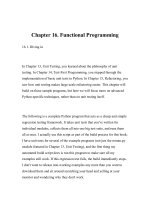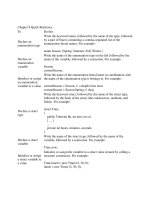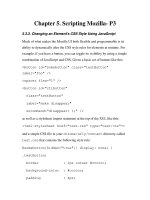Chapter 9 - Object-Oriented Programming Inheritance docx
Bạn đang xem bản rút gọn của tài liệu. Xem và tải ngay bản đầy đủ của tài liệu tại đây (338.97 KB, 84 trang )
2003 Prentice Hall, Inc. All rights reserved.
1
Chapter 9 - Object-Oriented
Programming: Inheritance
Outline
9.1 Introduction
9.2 Base Classes and Derived Classes
9.3 protected Members
9.4 Relationship between Base Classes and Derived Classes
9.5 Case Study: Three-Level Inheritance Hierarchy
9.6 Constructors and Destructors in Derived Classes
9.7 “Uses A” and “Knows A” Relationships
9.8 public, protected and private Inheritance
9.9 Software Engineering with Inheritance
2003 Prentice Hall, Inc. All rights reserved.
2
9.1 Introduction
•
Inheritance
–
Software reusability
–
Create new class from existing class
•
Absorb existing class’s data and behaviors
•
Enhance with new capabilities
–
Derived class inherits from base class
•
Derived class
–
More specialized group of objects
–
Behaviors inherited from base class
•
Can customize
–
Additional behaviors
2003 Prentice Hall, Inc. All rights reserved.
3
9.1 Introduction
•
Class hierarchy
–
Direct base class
•
Inherited explicitly (one level up hierarchy)
–
Indirect base class
•
Inherited two or more levels up hierarchy
–
Single inheritance
•
Inherits from one base class
–
Multiple inheritance
•
Inherits from multiple base classes
–
Base classes possibly unrelated
•
Chapter 22
2003 Prentice Hall, Inc. All rights reserved.
4
9.1 Introduction
•
Three types of inheritance
–
public
•
Every object of derived class also object of base class
–
Base-class objects not objects of derived classes
–
Example: All cars vehicles, but not all vehicles cars
•
Can access non-private members of base class
–
Derived class can effect change to private base-class
members
•
Through inherited non-private member functions
–
private
•
Alternative to composition
•
Chapter 17
–
protected
•
Rarely used
2003 Prentice Hall, Inc. All rights reserved.
5
9.1 Introduction
•
Abstraction
–
Focus on commonalities among objects in system
•
“is-a” vs. “has-a”
–
“is-a”
•
Inheritance
•
Derived class object treated as base class object
•
Example: Car is a vehicle
–
Vehicle properties/behaviors also car properties/behaviors
–
“has-a”
•
Composition
•
Object contains one or more objects of other classes as
members
•
Example: Car has a steering wheel
2003 Prentice Hall, Inc. All rights reserved.
6
9.2 Base Classes and Derived Classes
•
Base classes and derived classes
–
Object of one class “is an” object of another class
•
Example: Rectangle is quadrilateral.
–
Class Rectangle inherits from class Quadrilateral
–
Quadrilateral: base class
–
Rectangle: derived class
–
Base class typically represents larger set of objects than
derived classes
•
Example:
–
Base class: Vehicle
•
Cars, trucks, boats, bicycles, …
–
Derived class: Car
•
Smaller, more-specific subset of vehicles
2003 Prentice Hall, Inc. All rights reserved.
7
9.2 Base Classes and Derived Classes
•
Inheritance examples
Base class Derived classes
Student GraduateStudent
UndergraduateStudent
Shape Circle
Triangle
Rectangle
Loan CarLoan
HomeImprovementLoan
MortgageLoan
Employee FacultyMember
StaffMember
Account CheckingAccount
SavingsAccount
2003 Prentice Hall, Inc. All rights reserved.
8
9.2 Base Classes and Derived Classes
•
Inheritance hierarchy
–
Inheritance relationships: tree-like hierarchy structure
–
Each class becomes
•
Base class
–
Supply data/behaviors to other classes
OR
•
Derived class
–
Inherit data/behaviors from other classes
2003 Prentice Hall, Inc. All rights reserved.
9
Single
inheritance
CommunityMember
Employee Student
Administrator Teacher
AdministratorTeacher
StaffFaculty
Alumnus
Single
inheritance
Single
inheritance
Multiple
inheritance
Fig. 9.2 Inheritance hierarchy for university CommunityMembers.
2003 Prentice Hall, Inc. All rights reserved.
10
Shape
TwoDimensionalShape ThreeDimensionalShape
Circle Square Triangle Sphere Cube Tetrahedron
Fig. 9.3 Inheritance hierarchy for Shapes.
2003 Prentice Hall, Inc. All rights reserved.
11
9.2 Base Classes and Derived Classes
•
public inheritance
–
Specify with:
Class TwoDimensionalShape : public Shape
•
Class TwoDimensionalShape inherits from class Shape
–
Base class private members
•
Not accessible directly
•
Still inherited
–
Manipulate through inherited member functions
–
Base class public and protected members
•
Inherited with original member access
–
friend functions
•
Not inherited
2003 Prentice Hall, Inc. All rights reserved.
12
9.3 protected Members
•
protected access
–
Intermediate level of protection between public and
private
–
protected members accessible to
•
Base class members
•
Base class friends
•
Derived class members
•
Derived class friends
–
Derived-class members
•
Refer to public and protected members of base class
–
Simply use member names
2003 Prentice Hall, Inc. All rights reserved.
13
9.4 Relationship between Base Classes
and Derived Classes
•
Base class and derived class relationship
–
Example: Point/circle inheritance hierarchy
•
Point
–
x-y coordinate pair
•
Circle
–
x-y coordinate pair
–
Radius
2003 Prentice Hall, Inc.
All rights reserved.
Outline
14
point.h (1 of 1)
1 // Fig. 9.4: point.h
2 // Point class definition represents an x-y coordinate pair.
3 #ifndef POINT_H
4 #define POINT_H
5
6 class Point {
7
8 public:
9 Point( int = 0, int = 0 ); // default constructor
10
11 void setX( int ); // set x in coordinate pair
12 int getX() const; // return x from coordinate pair
13
14 void setY( int ); // set y in coordinate pair
15 int getY() const; // return y from coordinate pair
16
17 void print() const; // output Point object
18
19 private:
20 int x; // x part of coordinate pair
21 int y; // y part of coordinate pair
22
23 }; // end class Point
24
25 #endif
Maintain x- and y-
coordinates as private data
members.
2003 Prentice Hall, Inc.
All rights reserved.
Outline
15
point.cpp (1 of 3)
1 // Fig. 9.5: point.cpp
2 // Point class member-function definitions.
3 #include <iostream>
4
5 using std::cout;
6
7 #include "point.h" // Point class definition
8
9 // default constructor
10 Point::Point( int xValue, int yValue )
11 {
12 x = xValue;
13 y = yValue;
14
15 } // end Point constructor
16
17 // set x in coordinate pair
18 void Point::setX( int xValue )
19 {
20 x = xValue; // no need for validation
21
22 } // end function setX
23
2003 Prentice Hall, Inc.
All rights reserved.
Outline
16
point.cpp (2 of 3)
24 // return x from coordinate pair
25 int Point::getX() const
26 {
27 return x;
28
29 } // end function getX
30
31 // set y in coordinate pair
32 void Point::setY( int yValue )
33 {
34 y = yValue; // no need for validation
35
36 } // end function setY
37
38 // return y from coordinate pair
39 int Point::getY() const
40 {
41 return y;
42
43 } // end function getY
44
2003 Prentice Hall, Inc.
All rights reserved.
Outline
17
point.cpp (3 of 3)
45 // output Point object
46 void Point::print() const
47 {
48 cout << '[' << x << ", " << y << ']';
49
50 } // end function print
2003 Prentice Hall, Inc.
All rights reserved.
Outline
18
pointtest.cpp
(1 of 2)
1 // Fig. 9.6: pointtest.cpp
2 // Testing class Point.
3 #include <iostream>
4
5 using std::cout;
6 using std::endl;
7
8 #include "point.h" // Point class definition
9
10 int main()
11 {
12 Point point( 72, 115 ); // instantiate Point object
13
14 // display point coordinates
15 cout << "X coordinate is " << point.getX()
16 << "\nY coordinate is " << point.getY();
17
18 point.setX( 10 ); // set x-coordinate
19 point.setY( 10 ); // set y-coordinate
20
21 // display new point value
22 cout << "\n\nThe new location of point is ";
23 point.print();
24 cout << endl;
25
Create a Point object.
Invoke set functions to
modify private data.
Invoke public function
print to display new
coordinates.
2003 Prentice Hall, Inc.
All rights reserved.
Outline
19
pointtest.cpp
(2 of 2)
pointtest.cpp
output (1 of 1)
26 return 0; // indicates successful termination
27
28 } // end main
X coordinate is 72
Y coordinate is 115
The new location of point is [10, 10]
2003 Prentice Hall, Inc.
All rights reserved.
Outline
20
circle.h (1 of 2)
1 // Fig. 9.7: circle.h
2 // Circle class contains x-y coordinate pair and radius.
3 #ifndef CIRCLE_H
4 #define CIRCLE_H
5
6 class Circle {
7
8 public:
9
10 // default constructor
11 Circle( int = 0, int = 0, double = 0.0 );
12
13 void setX( int ); // set x in coordinate pair
14 int getX() const; // return x from coordinate pair
15
16 void setY( int ); // set y in coordinate pair
17 int getY() const; // return y from coordinate pair
18
19 void setRadius( double ); // set radius
20 double getRadius() const; // return radius
21
22 double getDiameter() const; // return diameter
23 double getCircumference() const; // return circumference
24 double getArea() const; // return area
25
Note code similar to Point
code.
2003 Prentice Hall, Inc.
All rights reserved.
Outline
21
circle.h (2 of 2)
26 void print() const; // output Circle object
27
28 private:
29 int x; // x-coordinate of Circle's center
30 int y; // y-coordinate of Circle's center
31 double radius; // Circle's radius
32
33 }; // end class Circle
34
35 #endif
Maintain x-y coordinates and
radius as private data
members.
Note code similar to Point
code.
2003 Prentice Hall, Inc.
All rights reserved.
Outline
22
circle.cpp (1 of 4)
1 // Fig. 9.8: circle.cpp
2 // Circle class member-function definitions.
3 #include <iostream>
4
5 using std::cout;
6
7 #include "circle.h" // Circle class definition
8
9 // default constructor
10 Circle::Circle( int xValue, int yValue, double radiusValue )
11 {
12 x = xValue;
13 y = yValue;
14 setRadius( radiusValue );
15
16 } // end Circle constructor
17
18 // set x in coordinate pair
19 void Circle::setX( int xValue )
20 {
21 x = xValue; // no need for validation
22
23 } // end function setX
24
2003 Prentice Hall, Inc.
All rights reserved.
Outline
23
circle.cpp (2 of 4)
25 // return x from coordinate pair
26 int Circle::getX() const
27 {
28 return x;
29
30 } // end function getX
31
32 // set y in coordinate pair
33 void Circle::setY( int yValue )
34 {
35 y = yValue; // no need for validation
36
37 } // end function setY
38
39 // return y from coordinate pair
40 int Circle::getY() const
41 {
42 return y;
43
44 } // end function getY
45
2003 Prentice Hall, Inc.
All rights reserved.
Outline
24
circle.cpp (3 of 4)
46 // set radius
47 void Circle::setRadius( double radiusValue )
48 {
49 radius = ( radiusValue < 0.0 ? 0.0 : radiusValue );
50
51 } // end function setRadius
52
53 // return radius
54 double Circle::getRadius() const
55 {
56 return radius;
57
58 } // end function getRadius
59
60 // calculate and return diameter
61 double Circle::getDiameter() const
62 {
63 return 2 * radius;
64
65 } // end function getDiameter
66
Ensure non-negative value for
radius.
2003 Prentice Hall, Inc.
All rights reserved.
Outline
25
circle.cpp (4 of 4)
67 // calculate and return circumference
68 double Circle::getCircumference() const
69 {
70 return 3.14159 * getDiameter();
71
72 } // end function getCircumference
73
74 // calculate and return area
75 double Circle::getArea() const
76 {
77 return 3.14159 * radius * radius;
78
79 } // end function getArea
80
81 // output Circle object
82 void Circle::print() const
83 {
84 cout << "Center = [" << x << ", " << y << ']'
85 << "; Radius = " << radius;
86
87 } // end function print









